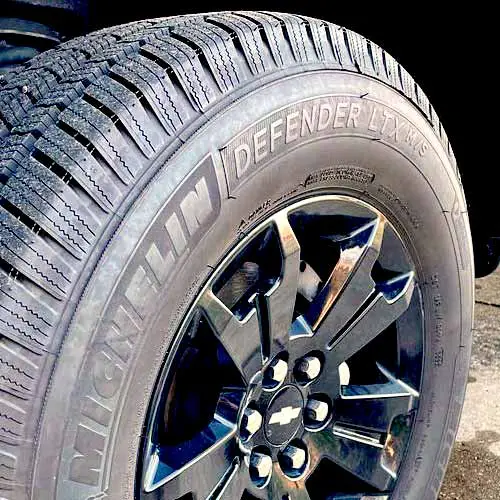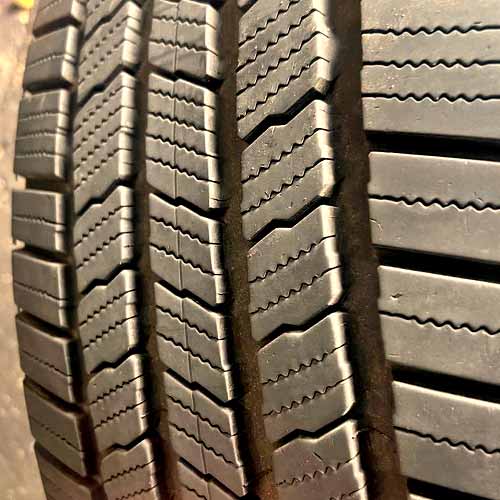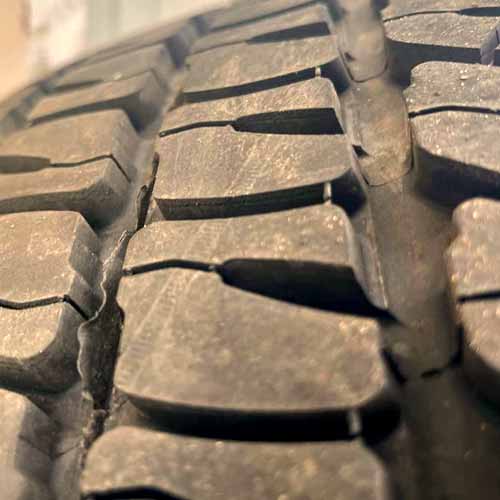Michelin Defender LTX AT2 is an all-terrain tire, while the LTX AT2 comes in the category of all season. Both tires bring a lot to the table. They both offer amazing on-road commute while keeping Though which of these big players gets the upper hand can get tricky. But let me make things easier for you.

In my expert opinion as a tire engineer, the Michelin LTX AT2 offers better off-road traction on rocks, gravel and mud. Moreover, you also get better tread life (when comparing LT sizes). The Defender LTX M/S on the other side features superior on-road traction, where although it’s dry performance is only marginally better, its wet traction take a huge lead. Moreover, the tire also does better in terms of fuel and comfort.
Tire Sizes
Starting things off with Michelin Defender LTX MS, the tire has following specs.
- Total Sizes: 68
- Rim Diameters: 15 to 22 inches
- Speed ratings: R, T and H.
- Load ratings: SL, XL, C and E
- Tread depth: 10 to 13/32″
- Weight range: 25 to 60 lbs
- Not rated with 3PMSF ratings
- 70k miles for P metric, and 50k for LT
Detailed review of this tire: https://tiredriver.com/michelin-defender-ltx-ms-review/
On the other side, the Michelin LTX AT2 comes in just 20 limited sizes in 15 to 20 inches, with following specs.
- Total Sizes: 20
- Rim Diameters: 15 to 20 inches
- Speed ratings: R, S and T
- Load ratings: SL, XL, C, D and E
- Tread depth: 14 to 17/32″
- Weight range: 32 to 60 lbs
- Not rated with 3PMSF
- 60k miles warranty on all sizes
Detailed review of this tire: https://tiredriver.com/michelin-ltx-at2-review/
Tread Apperance
Starting things off with Michelin Defender LTX MS.

So this tires comes with a conventional 5 rib structure, making straight longitudinal grooves.
In the middle you see 4 of these circumferential channels, formed by blocks with equal proportions.
All these lugs have squiggly siping on them, off-set edges, and their lateral gaps supply in-groove biters.
The shoulder lugs have similar features, though they are elongated.
They also carry similar siping pattern, which also gets to extend down towards the sidewalls a little bit.
Though there are no proper sidewall lugs seen on this tire.
Michelin LTX AT2 on the other hand also comes with longitudinal columns, though it’s more aggressive in comparison.

The 3 ribs in the middle make continuous running channels, meaning, the lugs are pasted on a secondary rubber layer underneath acting as reinforced foundational supports for these blocks.
This basically gives these blocks on-road stability, so that they don’t bend too much with a lot of tread depth that they have.
Moreover, all these lugs have a similar design. They are seen with notches which get attached to full depth sipes, off-set edges and wide enough tread voids in between to connect all vertical channels.
Shoulder lugs are different. They are elongated, have X shaped sipes/notches, and they extend down towards sidewalls a little bit forming staggered more aggressive (comparatively), pattern.
Ride Comfort
In terms of general ride comfort, two elements are key: tire tread noise and road imperfection absorption via tire structure and composition. I’ll elaborate further.
Road Vibrations
The quality of a tire’s ride is dependent on its ability to effectively manage road irregularities, largely determined by its composition.
And let me tell you, it really makes sense why Michelin Defender LTX MS is so good at it.
It’s tread is very soft and cushiony. I mean you can easily bend its lugs with your hand. That’s why it gets to soak up all the imperfections of the road in a better way.
Michelin LTX AT2 on the hand, although has a lot of tread depth, providing a larger rubber layer between you and the bumps, with stiffer compound, its still not as effective in comparison.
Road Noise
Ever wondered why less aggressive tires are quieter on roads? Well this is because they are not that bald. Meaning their tread to voids ratio is better. And this gives air particles less room to hit around and generate noise.
That’s why Defender LTX M/S being an all season tire gets to be quieter.
Michelin LTX AT2 on the other side, is not only voided more, it’s greater tread depth also allows the air particles a larger playground.
So they collide with the walls with greater force, and render greater on-road noise.
Dry Performance
To comprehend the dry performance of these tires, I analyzed their directional and lateral grip, as well as steering response. Let me share my findings with you.
Directional Grip
The factors that influence the tire’s dry “grip” performance include rolling resistance, weight, rubber composition, and tread pattern.
And here, the tread pattern determines the amount of rubber in contact with the road surface, while the central part of the tread determines the directional grip.
Central area is significant here, as it gets to bear the most weight pressure on it, as the tire rolls straight. That’s why this grip is measured with braking distances.
And considering both tires, its not a surprise to see the Michelin Defender LTX MS outperforming its bigger brother. The tire is more streamlined towards on-road manners, with it’s longitudinal ribs, offering a larger footprint to meet up with the roads surface.
The Michelin LTX AT2 on the other hand, comes with wider tread voids, and since blocks have a lot of notches and tread features on them, its rubber area gets eaten off, and it can’t contact the surface with similar footprint.
Dry Handling
The handling of a tire depends on two things, tread flexibility and shoulder’s footprint (connecting with the road).
And here again the Michelin Defender LTX MS takes the bigger piece of the pie. It’s outer ribs are more packed up (which get the most weight pressure on them, on corners). So you get superior lateral traction.
And although the tire weighs more, its shorter tread depth keeps lugs stable, and they don’t want to flex too much, keeping a great balance between under and over steering.
Michelin LTX AT2 on the other side, can’t offer similar steering response, and with it, handling times. Its offers smaller contact patch, and with deeper tread voids, they get to bend more while turning.
So out of both, I’d go with LTX M/S as a better daily driver on dry roads.
Wet Traction
Wet roads necessitate a tire with a balanced approach to both grip and hydroplaning resistance. Both of these are achieved through efficient water removal capabilities.
So I decided to divide this section in to these two.
Hydroplaning
Water is not compressible, that means if its not pushed out of the tread in time, a tire would float (this is the definition of hydroplaning by the way).
Though both tires have good enough longitudinal grooves, to let the water out in time. So that’s not going to be an issue.
But still, even though majority of water gets escaped out with these grooves, some still gets stuck behind and come directly in contact with the lugs (and they define grip).
Wet Grip
The left over water is dealt with sipes, they suck water in their slits, and clear off path that way.
And looking at both tires its easily understood, why Michelin Defender LTX MS, with greater number of sipes, softer tread, and better siping design, takes the lead (by a larger margin should I add).
With interlocking siping structure, the slits get to breath water with more ease, as they don’t get stiffer with the movement of the tire. And softer compound adds to their suction-creating abilities.
Michelin LTX AT2 on the other side, can’t offer similar wiping abilities, as it’s harder tread don’t allow the sipes to bend or flex as easily.
Fuel Economy
The rolling resistance of the tires influences fuel consumption, with the weight, tread pattern, and composition of the tire being the key determinants.
But in case of these two tires, both have similar structural weights, so we have to look at other two areas to explain why Michelin Defender LTX MS shows superior fuel economy.
With closed up lugs arrangement, the tire’s tread gets to divide the similar weight across more number of lugs. So each lug has smaller bearing pressure upon itself. So they don’t rub off the surface with as much friction, limiting rolling resistance.
Furthermore, with smaller tread depth, the lugs don’t get to flex too much, even though, the tire’s composition is softer comparatively. This means energy is not wasted in to bending of the lugs, and is rather consumed in to the rolling of the tire.
Michelin LTX AT2 on the other hand puts more pressure on it’s lugs, and with notches (having less streamlined structure), you get larger rolling resistance values, and with it fuel consumption.
Snow Traction
Both tires are missing with 3 peak mountain snowflake ratings, and only come with M+S. Though still out of them, the Michelin LTX A/T2 gets to have a upper hand, thanks to its numerous biting edges.
The siping slits connecting with the notches all over the tread provide ample snow grabbing capabilities, and the tread depth reaching up to 17/32″ ensures above average performance even on deeper terrains.
Michelin Defender LTX MS on the other side, although has a lot of siping as well, the tire lacks in snow scooping abilities, as longitudinal grooves do nothing for the snow traction.
Internal Construction
Although both tires come in different categories, they both have similar internal construction, well except for cap plies.
Both of them have 2 ply polyester casings, which are then layered with 2 steel belts. But on Defender LTX MS you get 2 ply nylon cap plies, whereas the LTX AT2 only gives you a single layer.
But that does not mean LTX AT2 is a weaker tire here. Its actually quite the contrary. The Michelin LTX AT2 basically has a cut resistant rubber and tread depth reaching up to 17/32″. So with such thick layer of stiffer rubber, you get better protection on mild off-road terrains.
Rugged-Terrain Traction
Off-road terrains can be vastly different, with mud being particularly challenging, while gravel and dirt filled tracks are easily handled. That’s why I’ve decided to cover all of them one by one.
On Mud
In mud, all-terrain tires face some big challenges due to their narrower grooves and there’s no way an all season tire would stand a chance here.
That’s why out of both, you are better off with Michelin LTX AT2. The tire although has pretty packed up lugs arrangement, they still make wider tread voids in comparison.
Michelin Defender LTX MS on the other side, gets packed with mud pretty quickly, and it’s lower tread depth, and missing shoulder scoops (staggered edges), aren’t helping the tire either.
On Rocks
When navigating rocky terrains, it is important to have a tire capable of providing strong grip in all directions and durability, especially on the sidewalls (as this terrain is where you see the majority of puncture, at-least that’s true for me).
Both tires although offer similar internal construction, with thicker rubber layer, you get superior durability on LTX AT2. Moreover, the tire also features a lot more biters in comparison, and they grip the rocky surface in a better way.
Sure, a supple tread compound could have helped this tire further, but that can be ignored, as things get better with lowered air pressure (By the way, see my guide on air pressure for these off-road tires).
Michelin Defender LTX MS on the other side, is missing with traction notches, as its blocky designed lugs don’t offer good enough biting abilities.
So I don’t recommend climbing rocks with this tire.
On Sand
Sand is a very tricky terrain, as it includes a lot of variables. Though all of them point towards a single thing, providing tire with floating abilities so it would not sink in. As digging is the worst enemy for sand traction.
And so out of both tires, I have to go with Michelin Defender LTX MS with its smoother outer edges, and softer tread compound.
The Michelin LTX AT2 on the other side, although comes with lighter sizes, it’s harder rubber, and serrated shoulders with saw-toothed edges tends to dig in more, comparatively.
Summing Up
So to sum things up, the Michelin Defender LTX MS being an all-season tire yields better results on pavements, and highways. You get to see better traction values on both wet and dry environments, and tire show superior fuel economy and tread life.
Moreover, it also does a lot better when it comes to providing a comfortable ride.
Michelin LTX AT2 on the other side, does better on all off-road terrains, it’s voided structure allows for better mud escaping, and it’s notches everywhere bring about superior grip on rocky terrains.